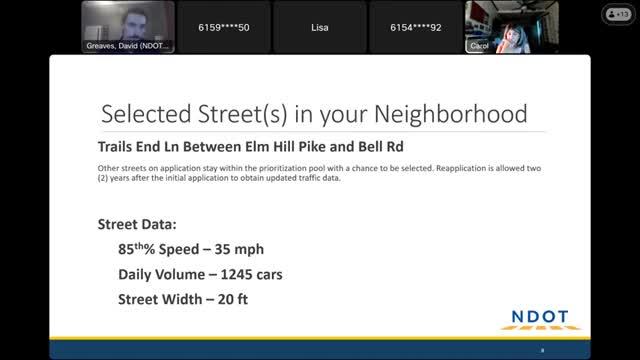Community pushes for urgent traffic calming measures
August 05, 2024 | Nashville Department of Transportation (NDOT) Meetings, Nashville, Davidson County, Tennessee

This article was created by AI summarizing key points discussed. AI makes mistakes, so for full details and context, please refer to the video of the full meeting. Please report any errors so we can fix them. Report an error »

During a recent government meeting, officials discussed traffic calming measures for Trails End Lane, a narrow street experiencing excessive speeding issues. The meeting highlighted the importance of designing roadways to a minimum width of 20 feet, which is crucial for implementing effective traffic management strategies.
The discussion included a review of the street layout, which stretches from Elm Hill Pike to Bell Road, and the potential for traffic cutting through the area. Officials acknowledged the challenges in definitively assessing traffic patterns but noted that the layout could contribute to the speeding problem.
Key traffic calming tools were presented, with speed cushions being the most common solution in Nashville. These rubber devices, designed to lower vehicle speeds to around 20-25 miles per hour, are effective while minimizing impact on emergency vehicles. The meeting also covered other options such as speed tables, radar feedback signs, lane narrowing, bulb outs, chicanes, and traffic circles, each with specific applications depending on roadway conditions.
Data from previous traffic calming projects indicated significant reductions in average speeds, with one study showing a drop from 31 miles per hour to 22 miles per hour after implementing these measures. The 85th percentile speed also decreased, indicating that fewer drivers were exceeding the speed limit.
Residents raised concerns about the current speeding situation, particularly on the downhill stretch from Bell Road, where speeds reportedly exceed 35 miles per hour. Officials clarified that the 35 mph figure represents the speed at which 15% of drivers exceed, not an average speed. They assured residents that Trails End Lane has already been selected for traffic calming measures, emphasizing their commitment to addressing the community's concerns.
The meeting concluded with plans for a site visit to Trails End Lane to gather further data and observations, ensuring that the proposed solutions are tailored to the specific needs of the neighborhood. Residents were encouraged to share any additional observations for consideration during the visit.
The discussion included a review of the street layout, which stretches from Elm Hill Pike to Bell Road, and the potential for traffic cutting through the area. Officials acknowledged the challenges in definitively assessing traffic patterns but noted that the layout could contribute to the speeding problem.
Key traffic calming tools were presented, with speed cushions being the most common solution in Nashville. These rubber devices, designed to lower vehicle speeds to around 20-25 miles per hour, are effective while minimizing impact on emergency vehicles. The meeting also covered other options such as speed tables, radar feedback signs, lane narrowing, bulb outs, chicanes, and traffic circles, each with specific applications depending on roadway conditions.
Data from previous traffic calming projects indicated significant reductions in average speeds, with one study showing a drop from 31 miles per hour to 22 miles per hour after implementing these measures. The 85th percentile speed also decreased, indicating that fewer drivers were exceeding the speed limit.
Residents raised concerns about the current speeding situation, particularly on the downhill stretch from Bell Road, where speeds reportedly exceed 35 miles per hour. Officials clarified that the 35 mph figure represents the speed at which 15% of drivers exceed, not an average speed. They assured residents that Trails End Lane has already been selected for traffic calming measures, emphasizing their commitment to addressing the community's concerns.
The meeting concluded with plans for a site visit to Trails End Lane to gather further data and observations, ensuring that the proposed solutions are tailored to the specific needs of the neighborhood. Residents were encouraged to share any additional observations for consideration during the visit.
View full meeting
This article is based on a recent meeting—watch the full video and explore the complete transcript for deeper insights into the discussion.
View full meeting
